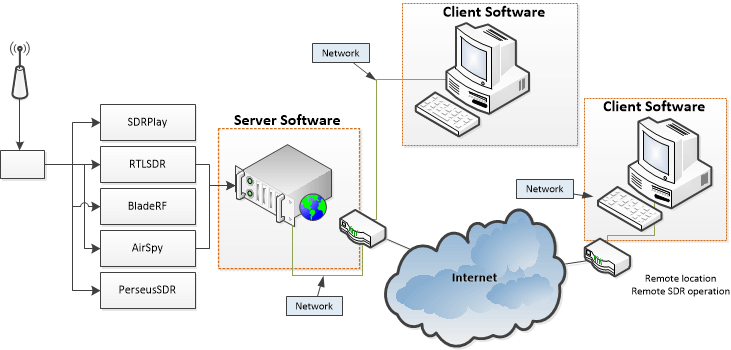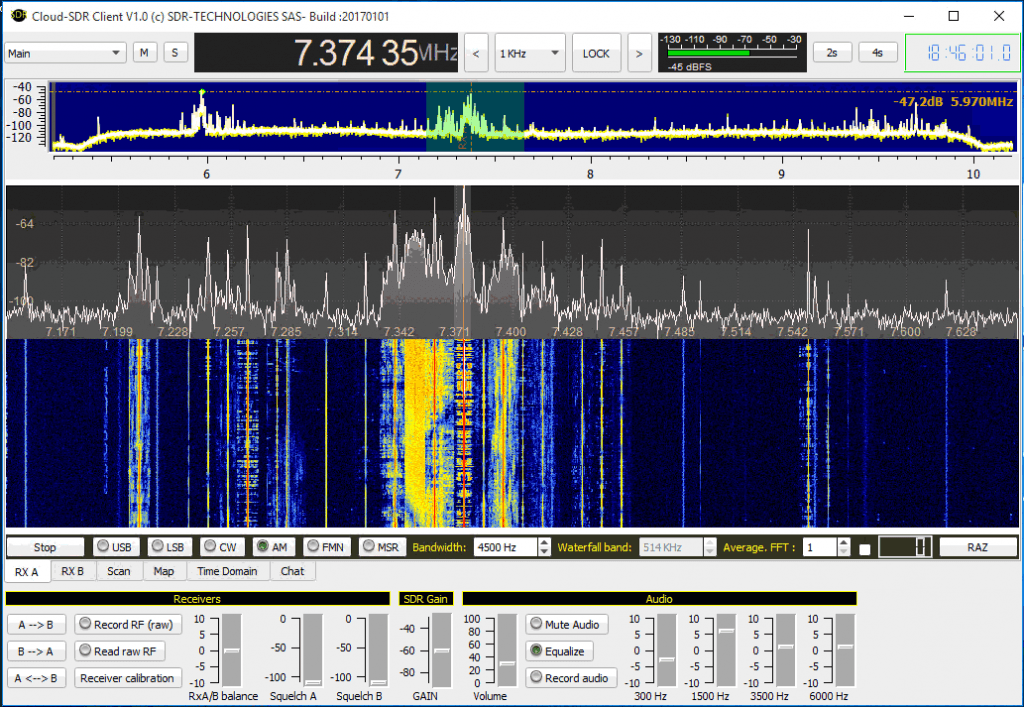Cloud-SDR Releases New Client and Server Software for the RTL-SDR
Cloud-SDR is a company that aims to make using SDR over the cloud/network/internet easier. It allows you to set up a remote SDR server that you can access from anywhere. Previously Cloud-SDR was still in development, but now we recently received mail from Cloud-SDR programmer Sylvain that the client and server software has just been released for the RTL-SDR. It appears that it also currently supports the Airspy, BladeRF, SDRplay and PerseusSDR.
The email reads:
I am pleased to inform you that we have just released two softwares compatible with your devices :
- The Cloud-SDR free client, a windows + Linux (to be released soon) client able to run locally RTL-SDR devices (check the news/turorials, we have featured several times dongles from your blog)
- The Cloud-SDR streaming server (codenamed SDRNode) , a windows + Linux (to be released soon) multi-user configurable streaming server.
SDRNode is a commercial software but an evaluation version is already available. Both softwares can be downloaded from our store after registration.
Source code for the drivers are already released as open source software through our GitHub repo: https://github.com/cloud-sdr
You can find more details here :

To download the software you must register an account with them at https://store.cloud-sdr.com/my-account. The client is free but the server costs 110 euros for personal and hobby usage, although a 30 day trial version is available. Currently only the Windows Client and Server are available, but they write that Linux should be available soon.
We tested the software out with an RTL-SDR V3. The client installation process was a simple wizard and after installation we launched the Cloud-SDR client by opening the shortcut “cSDRc” in the Start Menu. We found that the hardware needed to be plugged in first for the client to recognize it. The client is basic, but can already demodulate USB/LSB/CW/AM/FMN without trouble. It also has some interesting features:
- Dual channel receiver: RXA and RXB are two totally independent receivers;
- Geographic integration: Display on map beacons, ADS-B reported airliners, known HF broadcast stations or any geo-localized information coming from the SDRNode server;
- GPS compatibility: plug a GPS receiver to your computer and track your location on the map, record signals with your position for later processing (coverage mapping etc.); display the UTC time;
- Digital Terrain Elevation: See the terrain elevation around your position, or in the direction of the antenna directly on the map (requires to download the free SRTM3 files from NASA, with 90m resolution);
- MP3 audio recording: record to mp3 the demodulated streams to reduce disk requirements;
- Chat with other users connected to the SDRNode Group: when used as a remote client for the SDRNode streaming server, you can interact with other users with messages or station spotting;
- Time-domain analysis: the MSR mode enables analysis of any sub-band and displays in real time the time domain signals of the selected spectrum portion. This sub-band can also be recorded (with geographic position if GPS is connected) and processed with provided MATLAB®.

Next we tested the evaluation version of the SDR-Node server software on a remote laptop with an RTL-SDR connected. Again installation was easy, just follow the wizard after ordering the evaluation version. SDR-Node installs itself as a Windows service which starts up automatically on boot. To set up the Node we followed the guide shown in the video below. To connect with the client you need to know the IP address of the remote computer, the port is 8080, and the certificate is displayed on the server PC SDR-Node dashboard. We note that we also had to disable the Windows firewall to get it to connect, but it should be possible to also add SDR-Node to the firewall whitelist.
When streaming it appears that only 1/4 of the SDR sample rate can only be sent over the network. There are also compression options which can be used on slower networks or the internet to reduce bandwidth. Using the interface while in network mode was slightly laggy, but the waterfall and audio was smooth.
Overall everything worked as expected and it looks to be a very useful tool. More information is available at cloud-sdr.com. Some already existing alternative remote SDR streaming software that supports the RTL-SDR includes rtl_tcp, the SDR Console V2 server, OpenWebRX and ShinySDR.
Store website is down…
Looks interesting but what is with all the frequency restrictions?
juice
The waterfall comes from CuteSDR, from Moe Wheatley, and was also used by gqrx who enhanced it.
The source code states :
/* + + + This Software is released under the “Simplified BSD License” + + +
* Copyright 2010 Moe Wheatley. All rights reserved.
* Copyright 2011-2013 Alexandru Csete OZ9AEC
*
* Redistribution and use in source and binary forms, with or without modification, are
* permitted provided that the following conditions are met:
*
* 1. Redistributions of source code must retain the above copyright notice, this list of
* conditions and the following disclaimer.
*
* 2. Redistributions in binary form must reproduce the above copyright notice, this list
* of conditions and the following disclaimer in the documentation and/or other materials
* provided with the distribution.
*
* THIS SOFTWARE IS PROVIDED BY Moe Wheatley “AS IS” AND ANY EXPRESS OR IMPLIED
* WARRANTIES, INCLUDING, BUT NOT LIMITED TO, THE IMPLIED WARRANTIES OF MERCHANTABILITY AND
* FITNESS FOR A PARTICULAR PURPOSE ARE DISCLAIMED. IN NO EVENT SHALL Moe Wheatley OR
* CONTRIBUTORS BE LIABLE FOR ANY DIRECT, INDIRECT, INCIDENTAL, SPECIAL, EXEMPLARY, OR
* CONSEQUENTIAL DAMAGES (INCLUDING, BUT NOT LIMITED TO, PROCUREMENT OF SUBSTITUTE GOODS OR
* SERVICES; LOSS OF USE, DATA, OR PROFITS; OR BUSINESS INTERRUPTION) HOWEVER CAUSED AND ON
* ANY THEORY OF LIABILITY, WHETHER IN CONTRACT, STRICT LIABILITY, OR TORT (INCLUDING
* NEGLIGENCE OR OTHERWISE) ARISING IN ANY WAY OUT OF THE USE OF THIS SOFTWARE, EVEN IF
* ADVISED OF THE POSSIBILITY OF SUCH DAMAGE.
*
* The views and conclusions contained in the software and documentation are those of the
* authors and should not be interpreted as representing official policies, either expressed
* or implied, of Moe Wheatley.*/
You may have noticed that the ownership of the code is not claimed in our website which states clearly:
The following software have been source of inspiration and are partially included in this work:
CuteSDR from Moe Wheatley, thanks for his work and excellent documentation.From his original code we reused the Fractional Resampler and the downconverter (with some fixes from gqrx)
Waterfall display + freq selection taken from gqrx (http://gqrx.dk/), by Alexandru Csete OZ9AEC
Map display from https://github.com/raptorswing
WGS84 code is Copyright (C) 2006 Mathias Froehlich – [email protected]
Spectrum display and buttons are based in part on the work of the Qwt project (http://qwt.sf.net).
FM demodulator comes from Liquid-SDR , http://liquidsdr.org/, from Joseph D. Gaeddert.
For more details on the included software libraries, please check the Licenses folder of your cSDRc installation.
Hmm, the waterfall looks like gQRX.
will not be surprised, if were used code from gQRX which is under GNU license.
not sure my original comment has been recorded.
+ The waterfall code was originally written by Moe Wheatley for the CuteSDR, then reused by Alexandru OZ9AEC for gqRX.
+ It is released Under the Simplified BSD License, you can check here : https://github.com/hainn8x/gqrx/blob/master/qtgui/plotter.cpp
This is said clearly in the client page on our website: http://www.cloud-sdr.com/cloud-sdr-client/
Forgive my extreme ignorance but, just to make me understand something more about how it works, what would be the difference between this and websdr.org and sdr.hu?
Max,
that’s a pretty good question you are raising here. There are differences explained in details in this post : Local or Remote SDR ? What are the options ?.
The conclusions we draw are (quoting the post):
* When only one remote connection is required and the network bandwidth is not a limitation, proprietary solutions or rtl_tcp like systems are the best option,
* If only one type of device (one manufacturer) is in use, use the proprietary solution if it fits your needs,
* When you only need to listen to analog modulations and no further processing is required, WebSDR approach is the one you need,
* When you need the “true signal” on a limited bandwidth or “offline” processing is required, Cloud-SDR is what you need.
Hope this helps,
73
Thank you Sylvain for the clarification; the flowcharts in the linked page are very helpful to undesrtand and the description is very clear. I will keep on following your pages.
73
110€?